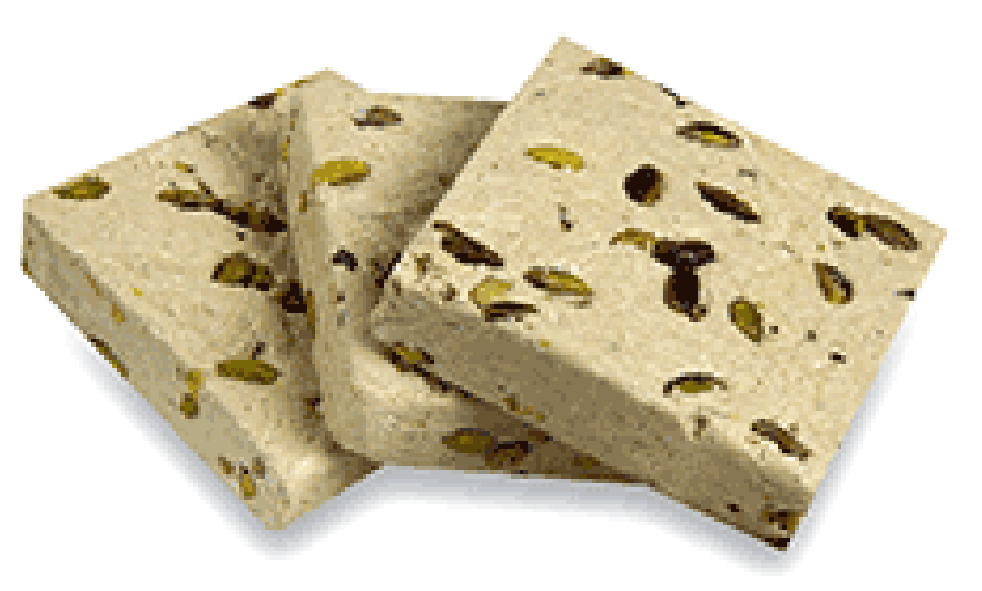 Tahini-based halva with pistachios and raisins, shown sliced.
Tahini-based halva with pistachios and raisins, shown sliced.
Welcome to the summary page for FabulousFusionFood's Cook's Guide entry for Halva along with all the Halva containing recipes presented on this site, with 18 recipes in total.
This is a continuation of an entire series of pages that will, I hope, allow my visitors to better navigate this site. As well as displaying recipes by name, country and region of origin I am now planning a whole series of pages where recipes can be located by meal type and main ingredient. This page gives a listing of all the Halva recipes added to this site.
These recipes, all contain Halva as a major wild food ingredient.
Halva is essentially a 'sweetmeat' or dessert depending on which version you're eating. The name itself (and its variants of halwa, halvah, halava, helva etc.) originally derived from the Arabic root حلوى halwa (sweet), is used to describe many distinct types of sweet confection, across the Middle East, Central Asia, and South Asia. Halva based on semolina is popular in Turkey, India, Pakistan, and Persia.
Another common type, based on tahini (sesame paste), is more popular in the eastern Mediterranean and Balkan regions, in countries such as Greece, Palestine and Lebanon. Halva may also be made from a variety of other ingredients, including sunflower seeds various nuts, beans, lentils, and vegetables—such as carrots, pumpkins, yams and squashes.
Halva can also have a wider variety of spices, nuts, fruits or vegetables included into the mixture.
This is a continuation of an entire series of pages that will, I hope, allow my visitors to better navigate this site. As well as displaying recipes by name, country and region of origin I am now planning a whole series of pages where recipes can be located by meal type and main ingredient. This page gives a listing of all the Halva recipes added to this site.
These recipes, all contain Halva as a major wild food ingredient.
Halva is essentially a 'sweetmeat' or dessert depending on which version you're eating. The name itself (and its variants of halwa, halvah, halava, helva etc.) originally derived from the Arabic root حلوى halwa (sweet), is used to describe many distinct types of sweet confection, across the Middle East, Central Asia, and South Asia. Halva based on semolina is popular in Turkey, India, Pakistan, and Persia.
Another common type, based on tahini (sesame paste), is more popular in the eastern Mediterranean and Balkan regions, in countries such as Greece, Palestine and Lebanon. Halva may also be made from a variety of other ingredients, including sunflower seeds various nuts, beans, lentils, and vegetables—such as carrots, pumpkins, yams and squashes.
Halva can also have a wider variety of spices, nuts, fruits or vegetables included into the mixture.
The alphabetical list of all Halva recipes on this site follows, (limited to 100 recipes per page). There are 18 recipes in total:
Page 1 of 1
| Arrowroot Halwa Origin: India | Halva Origin: Iran | Hazelnut Halva Origin: Fusion |
| Beetroot Halwa Origin: India | Halva Origin: Lebanon | Kadu Ka Halwa Origin: India |
| Carrot Halwa Origin: Fusion | Halva de Floarea Soarelui (Sunflower Seed Paste Halva) Origin: Romania | Kazakh Halvah Origin: Kazakhstan |
| Carrot Halwa Spring Rolls Origin: Fusion | Halva Fudge Origin: Greece | Simple Sesame Halva Origin: Arabic |
| Gajar Ka Halwa (Carrot Halwa) Origin: India | Halvah Origin: Jewish | Sunflower and Peanut Halva Origin: Russia |
| Halawa Tahiniya (Sesame Seed Paste Halva) Origin: Egypt | Halvah with Butter Origin: Albania | Tusha Halwa Origin: Bangladesh |
Page 1 of 1